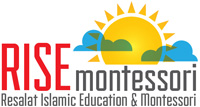Practical life
- buttoning, zipping, bow tying, and lacing pouring, scooping and sorting activities, as well as washing a table and food preparation to develop hand-eye coordination polite manners, such as folding hands, sitting in a chair, walking in line
Sensorial
- to experience the natural order of the physical environment
- pink tower (series of ten sequential cubes, varying in volume); knobbed cylinders (wooden blocks with 10 depressions to fit variable sized cylinders); broad stairs (ten wooden blocks, sequentially varying in two dimensions); color tablets (colored objects for matching pairs or grading shapes of color).[43]
Cultural subjects
- Geography & History map puzzles, globes, cultural suitcases containing country-specific materials
- Biology naming and organizing plants and animals
- Science Mighty Magnet Motorized Solar System Earth Science etc
- Research by K. Dohrmann and colleagues[62] supplements this by showing superior math and science performance in high school by children who previously attended public Montessori (as compared to high school classmates, over half of whom were at the most selective city public high schools); and two studies by Rathunde and Csikszentmihalyi[63][64] showing a higher level of interest and motivation while doing school work as well as more positive social relations among Montessori middle-schoolers as opposed to matched controls.
- Results for 5-year-olds. Montessori students achieved higher scores [converted to average z scores (18)] for both academic and behavioral tests
- Results for 12-year-olds. Students in the Montessori program wrote more sophisticated and creative stories and showed a more developed sense of community and social skills
http://www.montessorimaterials.org/

